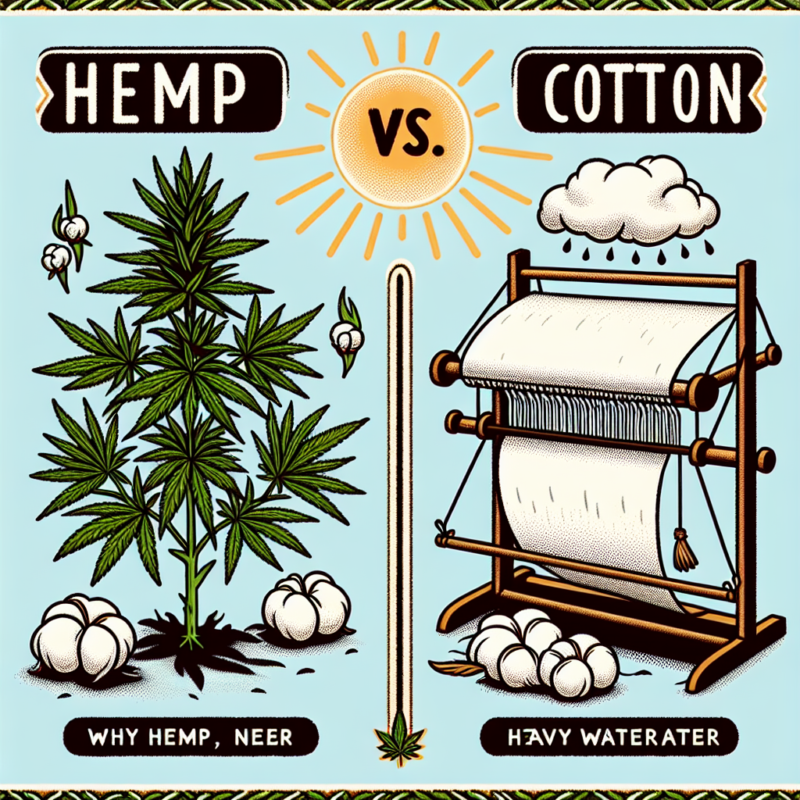Hemp vs. Cotton: Why Hemp is the Sustainable Fabric of the Future
As the fashion industry seeks to reduce its environmental impact, the conversation around sustainable fabrics has gained momentum. Among various options, two prominent crops—hemp and cotton—often take center stage. While both can serve as raw materials for textiles, hemp emerges as the superior choice for sustainability, owing to its lower resource requirements, biodegradable nature, and versatility.
The Resource Consumption Dilemma
One of the most significant factors to consider in the sustainability debate is resource consumption, particularly water and land usage. Cotton is notorious for its high water requirements. According to estimates, it takes about 7,000–29,000 liters of water to produce one kilogram of cotton, depending on farming practices and climatic conditions. Traditional cotton farming also requires significant amounts of pesticides and fertilizers, contributing to soil degradation and water pollution.
In contrast, hemp is a hardy plant that thrives with much less water—around 2,000 liters per kilogram—and is capable of flourishing in various soil types. It requires fewer pesticides and fertilizers, as it has natural pest-repelling qualities and helps improve soil health through its deep root system, which prevents soil erosion and enhances nutrient cycling. The resilience of hemp makes it a better fit for sustainable farming practices.
Biodegradability and Environmental Impact
In today’s throwaway culture, the environmental impact of textiles extends beyond mere production; the end-of-life disposal is equally crucial. Cotton fibers degrade relatively faster than many synthetic materials, but when compared to hemp, they still fall short. Hemp fibers can decompose in a matter of weeks rather than the months or years that cotton might take.
Moreover, hemp production promotes carbon sequestration, drawing down carbon dioxide from the atmosphere and helping mitigate climate change. While cotton absorbs some carbon dioxide during its growth stages, the sheer volume of water, pesticides, and fertilizers used in its cultivation often offsets these benefits. On the other hand, hemp farms can yield more biomass, leading to greater carbon capture and storage in the soil.
Versatility and Durability
Hemp’s versatility cannot be overstated. The fibers extracted from hemp can be spun into strong, durable textiles and can also be blended with other materials, such as organic cotton or synthetics, to create high-performance fabrics. Hemp has a natural resistance to UV light and mold, making it long-lasting and ideally suited for a variety of applications, from clothing to home textiles and industrial uses.
Cotton, while widely regarded for its softness and comfort, lacks the durability that many consumers are starting to seek in sustainable products. As the demand for quality products increases, hemp’s strength gives it an edge, allowing for longer-lasting and more sustainable textile solutions.
The Economic Perspective
Transitioning to hemp can also create economic opportunities for farmers and manufacturers. With its fast growth cycle—typically maturing in just 100 days—hemp can offer farmers a quicker return on investment compared to cotton, which takes longer to harvest. Furthermore, as industry interest in sustainable practices swells, the market for hemp products is poised to grow, providing new avenues for economic development.
Cotton, although widely cultivated, relies heavily on monoculture practices that can deplete soil health and biodiversity. Hemp farming can promote crop rotation, which not only enriches the soil but also manages pests organically.
Challenges Ahead
While hemp boasts many advantages over cotton, it does face challenges in the market, primarily due to outdated regulations and a lack of infrastructure for processing. The stigma surrounding hemp, largely due to its association with marijuana, has hindered its widespread adoption in the textile industry.
However, as perceptions shift and regulations become more favorable, the potential for hemp to lead the way in sustainable textiles becomes clearer. Increased investment in technology and education surrounding hemp farming and production processes will be crucial for overcoming these barriers.
Conclusion
As consumers become more conscious of the environmental impact of their purchases, the urgency for sustainable fabric alternatives intensifies. Hemp stands out as the fabric of the future, offering an ecological solution that meets modern needs without compromising the health of our planet. With its lower resource consumption, biodegradability, durability, and economic potential, hemp could very well lead the textile revolution, replacing cotton as the sustainable fabric of choice. The time has come to embrace this versatile crop and promote a more sustainable and responsible fashion industry.

